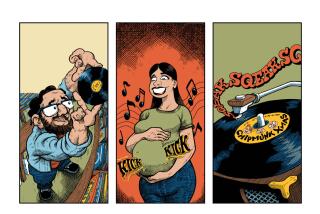Whatever happened to 8mm tape? : VIDEO’S ‘FORMAT OF THE FUTURE’ STILL LAGS BEHIND VHS
- Share via
Remember back in 1985, when 8mm was introduced and touted as the video tape format of the future? Well, the future is here, and VHS is still the dominant format. So far, as the format of the future, 8mm has been a fizzle.
Look at the evidence. Are 8mm products commonplace? Are 8mm VCRs the rage? Is your local video store packed with 8mm prerecorded tapes? Do video stores stock all the latest movies in 8mm?
The answer to all these questions is a resounding no.
What has kept 8mm down is the popularity of VHS, which grows more firmly entrenched each year. This format has some advantages over VHS-particularly compactness, with 8mm boasting a miniature cassette that’s smaller than an audiocassette. When comparing color and detail of images, 8mm is superior to VHS.
But VHS dominates in the key areas. You can buy a good VHS VCR for $250 to $300 and decent VHS blank tapes-good for up to six hours of recording-for a couple of dollars. While VHS products are affordable by the masses, 8mm products are much more expensive-in the upscale range.
What’s keeping 8mm alive is the lucrative camcorder market, where smaller and more compact is better. Sony, which developed 8mm, dominates the camcorder market and is consistently coming up with expensive toys like the Video Walkman- introduced in late 1988-which is a tiny, battery-operated portable unit marrying the 8mm VCR with the three-to four-inch LCD color TV. While Sony is advancing 8mm in what’s known as the personal video market, 8mm continues to lag behind in availability of prerecorded tapes.
VHSU ace in the hole is that the market for prerecorded movies is mostly geared to the VHS VCR population.
Considering that there are so few 8mm prerecorded tapes on the market, selling these mini-TV/VCRs is tougher. What good are these little TV-VCRs if you can’t use them to watch the movie of your choice?
Eight-millimeter doesn’t even dominate the camcorder market- VHS does. Just 40% of this market belongs to 8mm. Consumers have purchased about 1.5 million 8mm camcorders.
The full-size VHS camcorders are bulkier than 8mm, but many consumers prefer the VHS products because of compatibility with their VHS VCRs. To fight miniformat with miniformat, JVC came up with the VHS-C, a smaller, compact VHS cassette used in a minicamcorder. With an adapter, the VHS-C cassette can be played in a VHS VCR.
If 8mm is going to chip away at the VHS monster, it will have to make available more prerecorded 8mm titles-movies in particular. Right now, there are about 1,500 8mm titles- typically priced at $29.95 each-on the market. But the selections are limited. For instance, if you like horror movies or X-rated movies, you’ll find little in 8mm to satisfy your tastes.
You can tape your own programs to watch in the 8mm format, but it’s not cheap. Eight-millimeter blank tapes, which record for up to two hours, are about $10. That’s expensive compared to VHS tapes, which are cheaper and offer more recording time.
There is a bright side to the 8mm prerecorded tape woes. Major video companies like Warner, Paramount and RCA/Columbia have released movies in 8 mm, and Sony has talked some national retailing chains-like Tower-into carrying prerecorded 8mm cassettes.
But at the video retail level, 8 mm faces another obstacle-laser discs. More and more stores are stocking up on laser discs. This market is booming because the hardware has become more affordable. In the last few years, laser discs have blitzed past 8 mm in the prerecorded film market. So now, 8 mm is also competing for valuable shelf space in video stores with laser discs.
Against such strong, double-barreled competition-VHS and laser discs-8 mm’s chances of making significant inroads in the prerecorded film market are even slimmer.
More to Read
The biggest entertainment stories
Get our big stories about Hollywood, film, television, music, arts, culture and more right in your inbox as soon as they publish.
You may occasionally receive promotional content from the Los Angeles Times.









